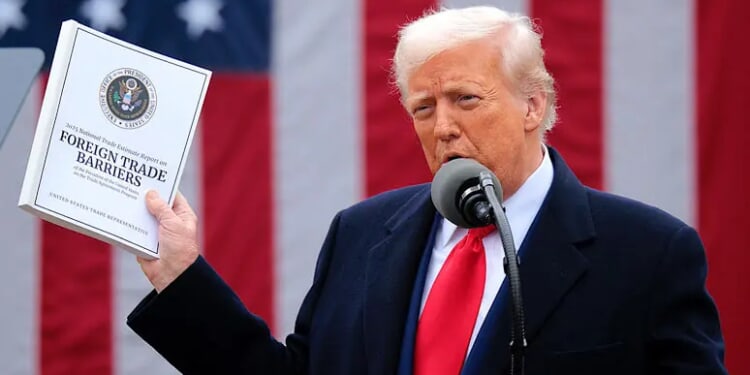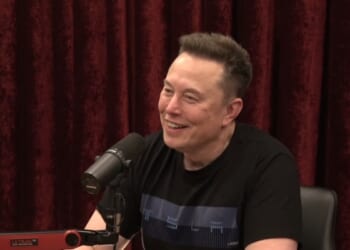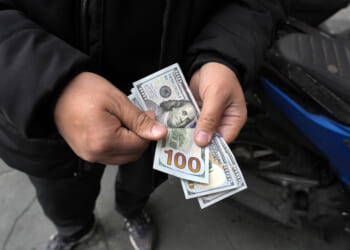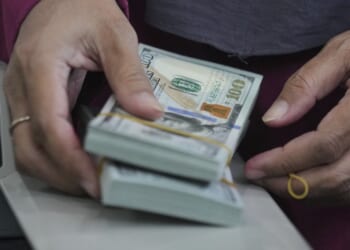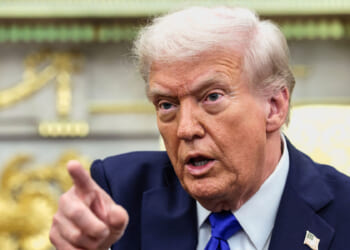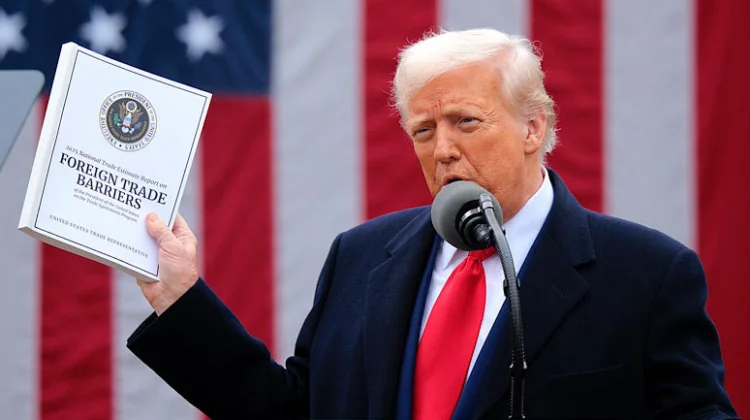
Order Michael Finch’s new book, A Time to Stand: HERE. Prof. Jason Hill calls it “an aesthetic and political tour de force.”
Sign up to attend Michael’s talk in Los Angeles on Thursday, November 20: HERE.
The Supreme Court heard oral arguments on November 5th about whether President Donald Trump exceeded his legal authority by unilaterally imposing tariffs on nearly all of America’s trading partners. The president declared national emergencies pursuant to the 1977 International Emergency Economic Powers Act (IEEPA) as the basis for imposing his sweeping world-wide tariffs. Several states and businesses challenged these tariffs as exceeding President Trump’s authority and prevailed in the lower courts, leading the Trump administration to appeal to the Supreme Court.
Although the justices’ questions and comments during oral arguments are not necessarily predictive of how the Supreme Court will rule, many Supreme Court observers are doubtful that President Trump will get the blank check he is seeking. Conservative Justices Neil Gorsuch, Amy Coney Barrett, and Chief Justice John Roberts joined their liberal colleagues in questioning the broad scope of President Trump’s assertion of tariffing authority without more specific authorization from Congress than the IEEPA provides. Justices Samuel Alito, Brett Kavanaugh, and Clarence Thomas, on the other hand, appeared somewhat more receptive to the Trump administration’s claim that the president has broad tariffing powers under the IEEPA in the event of a declared emergency.
Article I, Section 8 of the Constitution gives Congress, not the president, the power to “lay and collect taxes, duties, imposts and excises, to pay the debts and provide for the common defense and general welfare of the United States…”.
Tariffs are generally considered to be taxes in that they are intended to raise revenue. Moreover, Article I, Section 8 also gives Congress the explicit power to “lay and collect” duties and imposts, which are terms that are often used interchangeably with tariffs. But the Trump administration is relying on the IEEPA to claim that Congress delegated to the president the authority to impose tariffs in the event he declares a grave national emergency.
The IEEPA does empower the president to “regulate” a variety of economic transactions “to deal with any unusual and extraordinary threat, which has its source in whole or substantial part outside the United States, to the national security, foreign policy, or economy of the United States, if the President declares a national emergency with respect to such threat.” These powers include the power to “regulate” by means of “licenses or otherwise,” the “importation or exportation of…any property in which any foreign country or a national thereof has any interest by any person, or with respect to any property, subject to the jurisdiction of the United States.” (Emphasis added)
The Trump administration argues that the president’s unilateral imposition of tariffs in the event he declares a serious national emergency is a legitimate exercise of the IEEPA’s grant of authority to the president to “regulate” the “importation” of foreign-owned property. The Supreme Court in previous cases has acknowledged that taxes can be legitimately used to regulate economic behavior in addition to their revenue-raising function.
However, such a sweeping assertion of presidential power poses a separation of powers problem. As Chief Justice John Roberts noted during the oral arguments, there is no specific reference to “tariff” in the IEEPA. Tariffs are a tax, he said, and the power to levy taxes has “always been the core power of Congress.”
Chief Justice Roberts also referred to the Court’s “major questions doctrine,” which requires explicit statutory authorization for executive actions that would have vast economic and political significance. He said that the major questions doctrine “might be directly applicable” in this case. That is because the tariffs President Trump is claiming he has the authority to impose are “on any product from any country…in any amount for any length of time.”
Justice Neil Gorsuch likewise pointed out that the Constitution designates Congress as having the power among the three branches of the federal government to set taxes, which he colloquially described as “The power to reach into the pockets of the American people.”
Justice Gorsuch also expressed concern about too much delegation by Congress of its legislative powers to the president that would, as a practical matter, be difficult for Congress to retrieve. “What president’s ever going to give that power back? A pretty rare president,” he said. “It’s a one-way ratchet toward the gradual but continual accretion of power in the executive branch and away from the people’s elected representatives.”
Justice Barrett questioned the nature of the threat that would justify imposing reciprocal tariffs “kind of across the board,” including even on countries such as Spain or France. The government’s attorney, Solicitor General D. John Sauer, responded that the emergency justifying the tariffs on virtually every trading power stems from the “longstanding sort of asymmetric unfair treatment” of America’s trade with these countries. In short, he explained that the reciprocal tariffs are a means to redress what he called “the trade deficit emergency” and to “stimulate the rebuilding of our hollowed-out manufacturing base.”
Relying primarily on the trade deficit rationale, however, to invoke the IEEPA’s emergency powers is a tricky proposition. While such trade deficits have existed for a long time during both parties’ administrations, no president before Mr. Trump has sought fit to use the IEEPA’s emergency provisions to unilaterally impose tariffs to reduce the trade deficits. Moreover, there is a separate statute, the Trade Act of 1974, that deals directly with the problem of “large and serious United States balance- of-payments deficits.” Unlike the IEEPA, the Trade Act of 1974 refers specifically to “duties” and establishes clear guardrails in granting temporary limited power to the president to impose duties in such circumstances, including a 15 percent cap and a 150-day limit.
Chief Justice Roberts may have offered at least a partial solution that would narrow the scope of the president’s tariffing power under the IEEPA but not eliminate it altogether. He said that while “tariffs are a tax and that’s a core power of Congress,” they are a “foreign-facing tax” and “foreign affairs is a core power of the executive.” He was searching for a way to reconcile these overlapping constitutional powers of the legislative and executive branches.
In trying to draw a discernible line in the tariff context, Chief Justice Roberts suggested that, aside from raising revenue, tariffs have been “quite effective in achieving a particular objective” of the president in his exercise of his power over foreign affairs.
The Court could draw a line by paying deference to the president’s foreign affairs and national security powers in using the IEEPA’s emergency authority but only as a diplomatic tool to urgently address an extraordinary threat from a foreign country. On the other hand, the president would not have carte blanche under the IEEPA to impose tariffs primarily to raise revenue or to reduce the trade imbalance. That is because only Congress has the power to raise revenue from taxes. And with respect to using tariffs primarily for trade balancing purposes, Congress has specifically delegated to the president more limited, time-bound authority in a separate statute.
Indeed, President Trump demonstrated how he has used tariffs in part as leverage to persuade foreign countries to change their behavior that poses an “unusual and extraordinary threat” to America’s national security and economy.
Fentanyl, for example, poses a clear and present danger to the lives and well-being of the American people. More than a quarter of a million Americans lost their lives from fentanyl overdoses since 2021 alone. Imposing tariffs on China, Canada, and Mexico to pressure these countries to stop the flow of fentanyl, directly or indirectly, into the U.S. should be well within the president’s IEEPA emergency powers to “regulate importation” by “licenses or otherwise.” (Emphasis added)
Another example of President Trump’s use of tariffs as a diplomatic tool to exert leverage was his response to China’s decision to ramp up export controls on its critical rare earth minerals and processing equipment. They are vital in producing semiconductors and many other advanced manufactured products that are critical to America’s national security and economy. The president used his threat, in his words, to “impose a Tariff of 100% on China, over and above any Tariff that they are currently paying” unless China backed off. An agreement was reached at a meeting between President Trump and Chinese President Xi Jinping at the sidelines of the APEC summit in Busan, South Korea that included China’s suspension of its rare earth export controls.
Justice Kavanaugh mentioned the tariff that President Trump imposed on India to dissuade India from continuing to purchase Russian oil, which was helping to fund Russia’s war against Ukraine and gave Russia less incentive to end the war.
Several justices also noted that outright embargoes are permitted under the IEEPA and asked why a president should be deprived of the ability to respond to a grave emergency with less drastic measures than an embargo, such as tariffs. Taking away “the President’s suite of tools when the one is much more extreme that is authorized…seems a bit unusual,” Justice Kavanaugh said.
In the event the Supreme Court decides to limit President Trump’s emergency powers under the IEEPA, he still retains tariffing powers under other statutes, although they are more cumbersome to implement and more limited in scope. He could invoke the Trade Act of 1974, including the trade imbalance provision mentioned above, and another provision that allows the use of tariffs following an investigation to enforce U.S. rights under trade agreements. He also could invoke the Trade Expansion Act of 1962, which authorizes tariffs for national security purposes after an investigation is first conducted.
Hopefully, the Supreme Court will at minimum permit the president to exercise his foreign relations and national security powers by imposing tariffs under the IEEPA as a diplomatic tool to urgently address an extraordinary threat from another country. And with respect to any tariffs the Supreme Court rules exceed the president’s IEEPA authority, the Court should give the Trump administration adequate time to pursue other statutory avenues to justify the tariffs before ordering any refunds.

